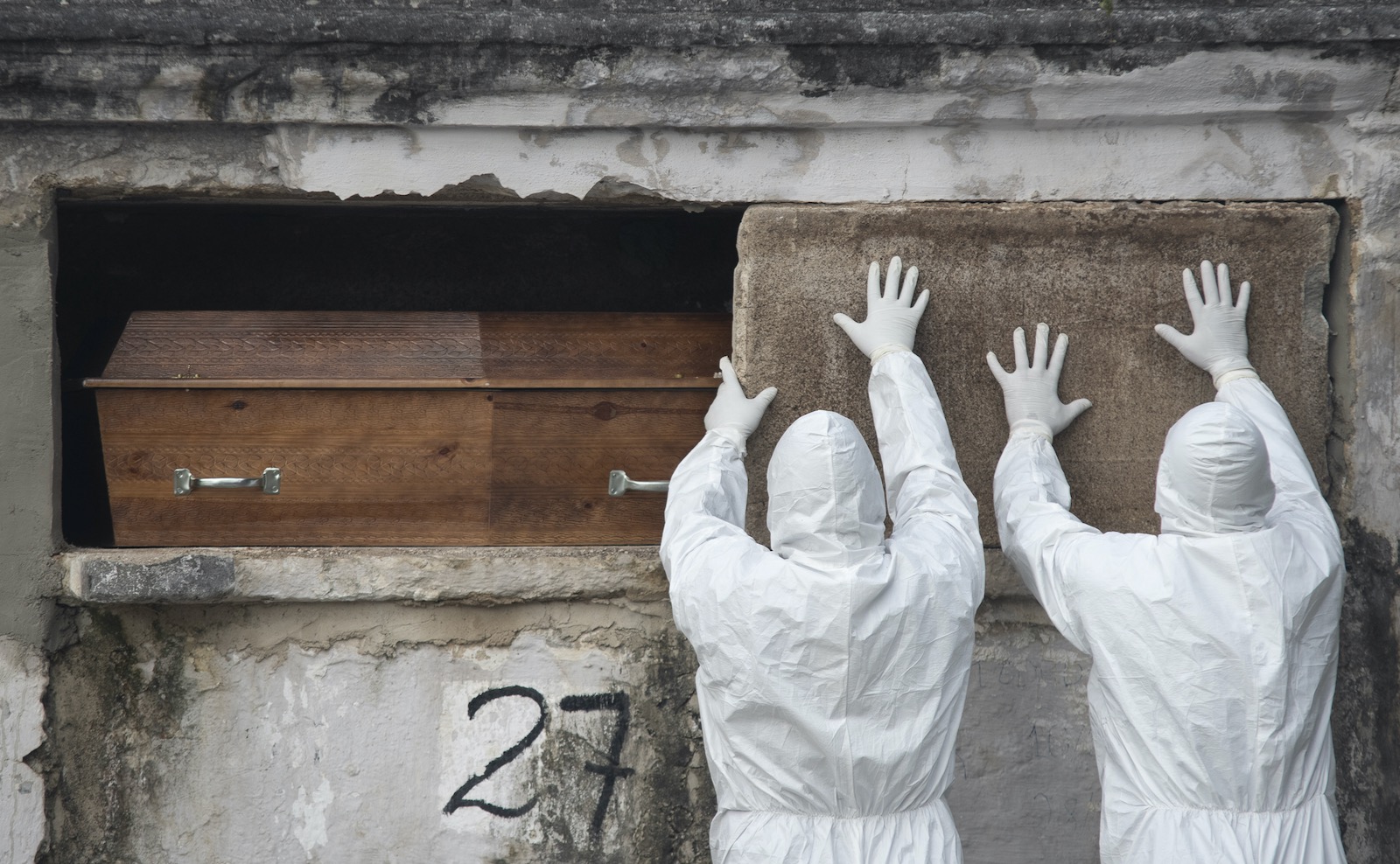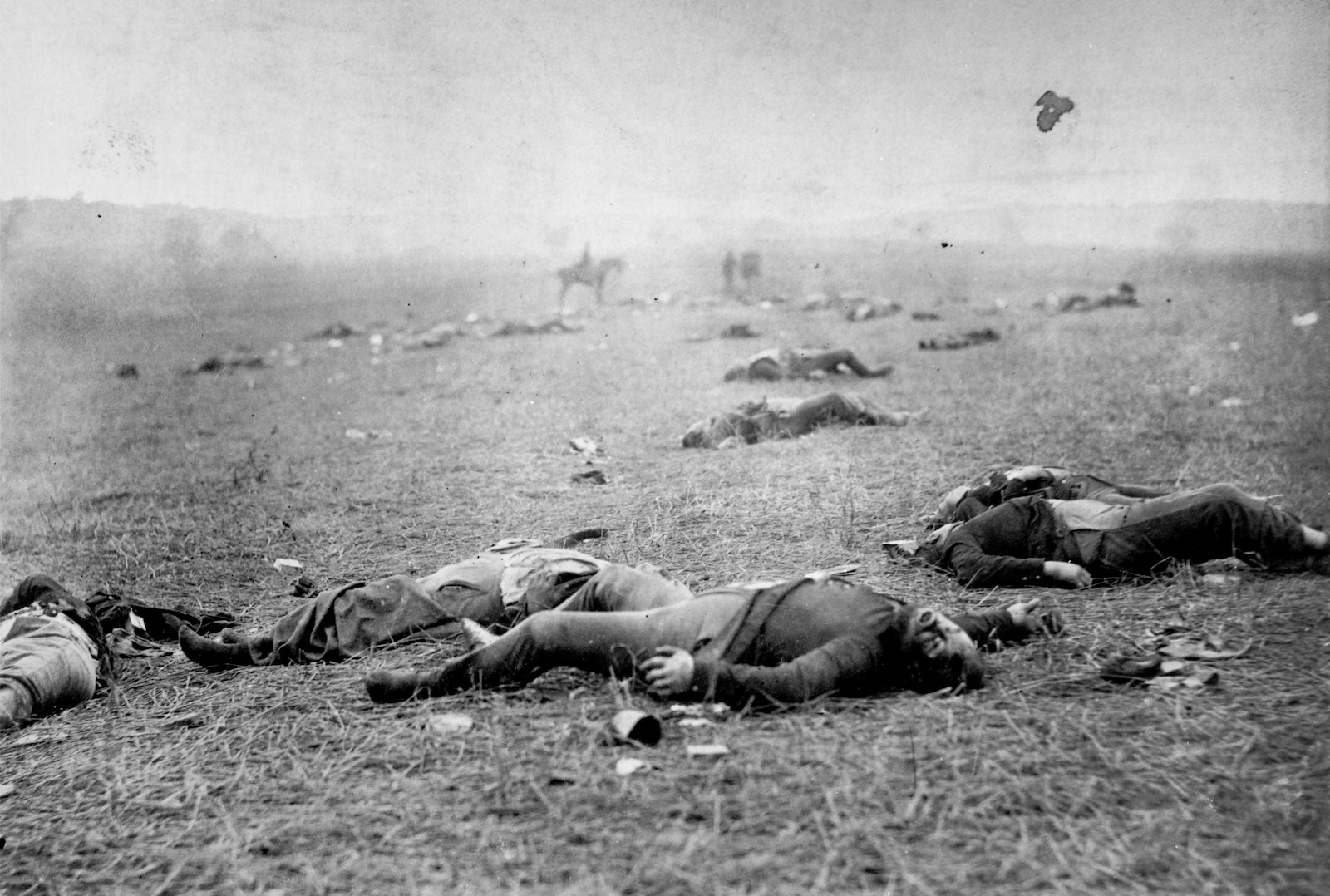A hundred and fifty years ago, slightly more, a strange notion: the dead could be counted. In the Civil War, in the lush fields of the South, Americans first, as a culture, began to imagine death in numbers. Rosters of soldiers, as well as lists of war casualties, were not common practice in the mid-nineteenth century. Many officials feared responsibility for the dead by numbering or naming them, and military leaders felt an accurate count might embolden their enemies.
Now, of course, we speak easily in the statistics of absence, of fifty dead in a mass shooting, of fourteen hundred missing in an earthquake, as if this has always been done. We live in a world of measurement, the mind ordered around quantities that tell us how to feel about loss and how to gauge the relative tragedy of an event.
It does seem very strange, then, that there was once a time when this was not the case. After all, people had been counting things for centuries before the Civil War: coins and acres and horses ten hands high. We had been counting one another: in the Book of Numbers, the Israelites count men and those men’s families, several times and through several generations of desert wanderers, giving the epic its name. These censuses confirmed God’s promise that the Israelites might propagate infinitely and thus keep their imagined future alive—as long as there were always more Israelites, there might always be a promised land to which they would return.
Before democratic modernity, there was some notion of mass. Just as humans counted each other and made certain cultural meaning from that counting, certainly humans in antiquity had powerful ideas about what it meant to be together. In English, the root of the word mass comes down through the Holy Mass, the religious gathering of people to worship and partake of the transmuted body of Christ. That transmutation, in the form of the Eucharist, was also often itself called the mass, as if the singular and historical body of Christ had undergone a very democratic transformation, from the one to the infinite.
Our most common contemporary usage comes from the scientific sense of mass—as in weight, as in the space taken up by an object in the world—and also by its attribution to large numbers of objects: figs, deeds, coins. In Geoffrey Chaucer’s The Book of the Duchess, “mass” is used to express an oath: “By the masse I durste swear,” he writes in a poem about death. Occasionally, even, “mass” was used to denote a sadness without name or source, a feeling of profound grief.
So it is not so much, then, that in the nineteenth century we began to count things, including our griefs, but that we began to give our counting meaning beyond numerical designation. The battlefield nurses, the mothers, sisters, and activists who worked across the South to aid soldiers and civilians, kept records of the dead in modes and for purposes that militaries had not, to that point, much bothered with, such as the notification of families. In the North, both public and private efforts to keep records of who enlisted and who was wounded were piecemeal, but they often gave great comfort to families, whose sons and fathers would otherwise be swept up and disappeared by the war.
After Appomattox, compiling a definitive statistical record of human loss became a preoccupation of the post-war recovery, as if numbering might, as the historian Drew Gilpin Faust put it, “re-bury the dead” and provide final solace. Americans needed a way outside of language or politics to make sense of enormous human loss. We know now from the meticulous work of those who lived through it—and later, from the work of historians—that more than 620,000 people died in the American Civil War. This is just slightly less than the number of Americans killed in all other wars, from the Revolution to Afghanistan, combined.
Much of the cultural need for numbers came from this profound loss. But a statistics of death was also a way of making every individual meaningful, even as that meaning was determined by the aggregate. The numbers themselves began to signify not just the relative scale of tragedy, but a philosophy of it. “Counting helped shift focus from individual to total, from death to the Dead,” writes Gilpin Faust. Yet this counting also did the opposite: it made death bearable by making it specific and contained, rather than abstract. To be counted was to have existed.
Advertisement
Americans needed, as a culture, a concept that encompassed this contradiction, that somehow addressed the ubiquity of violence, its proportion and its mortal toll, while retaining a sense of human scale and of human intimacy. They could not live with Walt Whitman’s “countless graves” or “infinite dead,” which failed to name both the specificity and the enormity of their loss.
Those who looked across the Southern battlefields, or viewed later the photographs of Mathew Brady, saw a tragedy that devastated them, but also one they could manage. Or, to borrow from Susan Sontag, they experienced a revulsion that was also, strangely, a celebration. This is the confluence that defines the spectacle: statistics, like photographs, have a kind of moral authority, one whose meaning may repel us but one that nevertheless encourages certainty, and thus anodyne. In such huge numbers, death may begin to seem, contradictorily, both individual and communal.
*
Like many people in the last few months, I have watched the numbers to learn how to feel about Covid-19 and “the war” currently being waged against it. I want to know when it might be over or contained, or how much risk or loss might accrue to me or my loved ones, given demographic data about age, race, sex, and region, and the numbers that represent economic markets. The epidemiological models that have saturated our news are not just projections of a possible or likely future; they are the metric by which enormous decisions about human activity have been and will be made. These statistics mitigate or inflame our fear; the numbers tangle with concepts like risk and freedom, and when they are sufficient or convincing or convenient, they determine policy. They determine when we might touch others, when we might return to restaurants, when we might again have toilet paper or instant yeast or childcare or jobs.
But these statistics are not likely to help us much in the true accounting ahead. Though history is recursive, there are moments when the previously unthinkable becomes thinkable. What helped usher in the Civil War notion of countable death was, on the one hand, the basic expansion of public education and the new accessibility of mathematics and statistics: put simply, by 1860 in the US, many more people than in any previous era knew how to do math.
But representational statistics—numbers that represent an average, like an approval rating, but also, more complexly, aggregations that produce majorities and minorities—took their first, partial shape in a revolution five thousand miles away from the Southern battlefields and seventy years earlier. The French Revolution, with its language of representation and the common man, set off a chain of global events that toppled monarchies and authoritative regimes, and ushered in the era of the democratic republic.
It is from the French Revolution that we get the term en masse, used to denote collectivity but also dissipation. Democracy, in both concept and execution, demanded the counting of human souls, in order to dispense resources and determine governmental representation. But it also meant relying on majorities to name and guide group experience, which overlaid and muddied, politically, the individual and empirical.
In the nascent American Republic, where some humans could vote and most others were in coverture to their voting husbands or were the property of those men, the notion of majority representation was corrupted a priori. Representative democracy was reframed—warped, in fact—through such ideas as republican motherhood, in which women’s voting rights were expressed not by them but by the male children they raised and educated. One of the great efforts of revisionist history in our own century has been to account for and number the slaves owned by Americans. The resulting calculations are both horrifying, because of their extremity, and empowering, because they give contour to the individual lives represented by those numbers.
The idea of “the masses” as an aggregation of people who, in that aggregation, surrender their specific traits to the traits of the group is thus a surprisingly recent one. The first recorded uses of the term en masse in English, to mean in a single body or all at once, are from the turn of the nineteenth century. The word “mass” applied to a gathering of persons who, in that very gathering, lose specificity and become indistinguishable as component parts is a notion of even greater novelty. The use of the term by political actors has served both radical and conservative ideologies. Gathered under one banner, early twentieth-century wage-earners cut across race, ethnicity, and vocation to form a new identity organized by relationship to production; the short-lived magazine of the Industrial Workers of the World was called The Masses. But the term also deployed as an antithesis to “cultured” or “learned”—the “sniveling” or “unclothed” masses—retains a vile power even now.
Advertisement
Only in the twentieth century do we see a proliferation of compounds referring to the effect of something on a large number of people at once: mass hysteria, mass consumption, mass grave, mass shooting. It is no wonder that the emergence of the masses—as phenomenon and idea—broadly coincides with the historical category of “genocide,” and with the many other categories that seek to define—or do terrible violence to—group identity. The numbering we used to determine political representation is now the primary way by which we understand very basic things about human life, such as affection and affiliation.
In the early twentieth century, Americans were already familiar with market and social research. Robert S. and Helen Merrell Lynd’s Middletown: A Study in American Culture (1929), a compendium of cultural behavior generated largely by surveys, was a national bestseller and claimed to enumerate the characteristics of the “average” American in a scientific mode. Later, at mid-century, Alfred Kinsey, in his famous studies of human sexual behavior, broadened the categorically “normal” to include the deviant or marginal. In each of these representative cases, statistics reified not just social affiliation but identity itself. Such data was used not only by social scientists to illuminate human behavior, but also by government agencies, executives, and even the Department of War to engineer human responses.
Today, we are polled about nearly everything, in order to be marketed or campaigned to. We give up information about our individual selves, willingly and every day, in order to enter the social aggregate of the technological twenty-first century. We know that numbers are used to represent a general experience, as well as to persuade and mislead. Still, we see numbers as nineteenth-century Americans did, as moral truths, forgetting—regardless of whether the numbers are accurate—that they are only one way of knowing, generated by certain logics and techniques, and not others.
Over time, the meaning and purpose of numbering has changed. The historian Sarah E. Igo writes that “statistical majorities” and other data “structure Americans’ social imaginations,” most strikingly in their understanding of themselves. Modern life is defined by the “peculiar tensions of life in a ‘mass’ society: between being ‘oneself’ and being known as a member of a group.” (More recently, Igo has written about privacy and the use of big data.)
We might call these the twin enthusiasms of the twenty-first century: the mass and its desires, its demands and preferences and vulnerabilities; and the quest for individual fulfillment. History often results in strange confluences and bedfellows. It persists in tensions that drive the plot.
Where these enthusiasms meet at the present moment is in ideas about identity and propriety: who has rights to what, and how those rights are determined; whose experiences are representational and therefore legitimate. We find such tension most readily in arguments about appropriation and in identity politics, as well as the subjugation of religious, cultural, or racial groups. The ability of any one person to speak authentically for others, to represent group experience or grievance, or to claim power based on group identity are constant sources of conflict in our modern world. But “representation” is not just a political notion; it pervades our fiction, our media, and our most intimate relationships.
Numbering the dead might have helped nineteenth-century Americans mourn, but such numbering exists in the lives of twenty-first-century Americans as a version of en masse: as Stalin’s cynical aphorism had it, “The death of one man is a tragedy; the death of millions is a statistic”—but today, in the US, ten thousand dead is not simply a statistic but a national emergency in which the epidemic itself is the tragedy. Or the proliferation of mass shootings is a tragedy; the opioid crisis is a tragedy. The numbering of the dead has shifted the site of mourning away from the singular death, and in this way has abstracted our significant grief, rather than contained it.
*
It is one strange confluence of history that 2020 is also a Census year in the United States. Already a crucial census, now the tabulation of human existence within geopolitical borders has another, mortally important aim. Surely the distribution of a Covid-19 vaccine—when or if one is developed—will be determined in part by how many people live where, how many people are known to have been ill or died.
Many commentators have warned of the risks of creating a statistical class of the immune. Writing about yellow fever in The New York Times, historian Kathryn Olivarius points out the powerful social hierarchies organized around immunity: in the antebellum Deep South, “immunity was more than a product of epidemiological luck […] it was wielded as a weapon” against black people and poor whites. Numbers of cases, recoveries, and deaths—as incomplete as we know they are—have and will determine hospital resources and basic necessities. Governors and local representatives have emerged, once again, as essential political actors, and as generators of these very numbers.
What we are experiencing now is a kind of violence to our understanding of “the masses,” and therefore to statistical and representational experience. I have no doubt that much of the future will be forged by the strange irony of our present moment: alone in our homes or tents or hospital beds, restricted from physical contact with one another, we are strangely and profoundly together. We are bound by a common experience in new, unprecedented, global numbers.
Yet this common experience is inflected by a thousand inequalities of detail. Within mere days of the first shelter-in-place orders, one could find Internet tattle about the post-coronavirus world, as if the disease had arrived, in disaster-movie fashion, to clean up the dustbin of our historical moment. Such speculation ranged from the grimly measured to the apocalyptic to the utopian.
Yet all of it acknowledged, in some way, that the world we live in is a wildly unequal one, one in which the politics of representation has overwhelmed our capacity for empathy, and the vagaries of le masse have made the moral accounting that accompanies tragedy empty and algorithmic. What many of us will want in the post-Covid-19 future is a new and better way to express collective grief.
How we will do that is an open question, but it will require a profound rethinking of the relationship between mass and individual, between communal and personal experience. An old friend of mine used to say, “Of course, every empirical example disrupts the totality.” She was paraphrasing Kant, and she herself was every inch the statistically average Kant paraphraser, as well as a chain-smoking owner of Persian cats and a Red Sox fan. She did not mean that the totality was not real and true, nor that the granularity of experience was false or without force, should it contradict what is generally known. The totality is powerful; the empirical has the power to disrupt it.
What terrifies us now, in our post-bellum world of numbers, is the representative individual: a man leaping from the second tower; the photograph of a single victim in a mass shooting; the captain of the USS Theodore Roosevelt. But what took my breath and changed my understanding of our current crisis was a photograph of a mass grave being dug in Potter’s Field on Hart Island in the Long Island Sound. There will be many uncounted and many unknown. When we emerge from our respective isolations, we will need a way to manage our grief and our losses. The numbers will not tell us how, nor will any single story.






